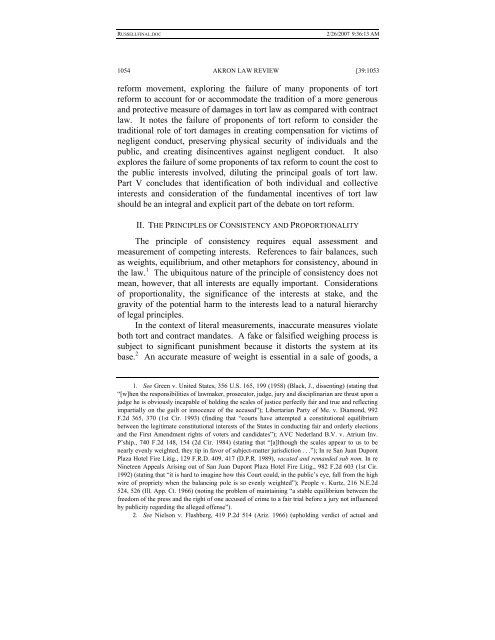THE LOGIC OF LEGAL REMEDIES AND THE RELATIVE WEIGHT ...
THE LOGIC OF LEGAL REMEDIES AND THE RELATIVE WEIGHT ...
THE LOGIC OF LEGAL REMEDIES AND THE RELATIVE WEIGHT ...
Create successful ePaper yourself
Turn your PDF publications into a flip-book with our unique Google optimized e-Paper software.
RUSSELLFINAL.DOC<br />
2/26/2007 9:36:13 AM<br />
1054 AKRON LAW REVIEW [39:1053<br />
reform movement, exploring the failure of many proponents of tort<br />
reform to account for or accommodate the tradition of a more generous<br />
and protective measure of damages in tort law as compared with contract<br />
law. It notes the failure of proponents of tort reform to consider the<br />
traditional role of tort damages in creating compensation for victims of<br />
negligent conduct, preserving physical security of individuals and the<br />
public, and creating disincentives against negligent conduct. It also<br />
explores the failure of some proponents of tax reform to count the cost to<br />
the public interests involved, diluting the principal goals of tort law.<br />
Part V concludes that identification of both individual and collective<br />
interests and consideration of the fundamental incentives of tort law<br />
should be an integral and explicit part of the debate on tort reform.<br />
II. <strong>THE</strong> PRINCIPLES <strong>OF</strong> CONSISTENCY <strong>AND</strong> PROPORTIONALITY<br />
The principle of consistency requires equal assessment and<br />
measurement of competing interests. References to fair balances, such<br />
as weights, equilibrium, and other metaphors for consistency, abound in<br />
the law. 1 The ubiquitous nature of the principle of consistency does not<br />
mean, however, that all interests are equally important. Considerations<br />
of proportionality, the significance of the interests at stake, and the<br />
gravity of the potential harm to the interests lead to a natural hierarchy<br />
of legal principles.<br />
In the context of literal measurements, inaccurate measures violate<br />
both tort and contract mandates. A fake or falsified weighing process is<br />
subject to significant punishment because it distorts the system at its<br />
base. 2 An accurate measure of weight is essential in a sale of goods, a<br />
1. See Green v. United States, 356 U.S. 165, 199 (1958) (Black, J., dissenting) (stating that<br />
“[w]hen the responsibilities of lawmaker, prosecutor, judge, jury and disciplinarian are thrust upon a<br />
judge he is obviously incapable of holding the scales of justice perfectly fair and true and reflecting<br />
impartially on the guilt or innocence of the accused”); Libertarian Party of Me. v. Diamond, 992<br />
F.2d 365, 370 (1st Cir. 1993) (finding that “courts have attempted a constitutional equilibrium<br />
between the legitimate constitutional interests of the States in conducting fair and orderly elections<br />
and the First Amendment rights of voters and candidates”); AVC Nederland B.V. v. Atrium Inv.<br />
P’ship., 740 F.2d 148, 154 (2d Cir. 1984) (stating that “[a]lthough the scales appear to us to be<br />
nearly evenly weighted, they tip in favor of subject-matter jurisdiction . . .”); In re San Juan Dupont<br />
Plaza Hotel Fire Litig., 129 F.R.D. 409, 417 (D.P.R. 1989), vacated and remanded sub nom. In re<br />
Nineteen Appeals Arising out of San Juan Dupont Plaza Hotel Fire Litig., 982 F.2d 603 (1st Cir.<br />
1992) (stating that “it is hard to imagine how this Court could, in the public’s eye, fall from the high<br />
wire of propriety when the balancing pole is so evenly weighted”); People v. Kurtz, 216 N.E.2d<br />
524, 526 (Ill. App. Ct. 1966) (noting the problem of maintaining “a stable equilibrium between the<br />
freedom of the press and the right of one accused of crime to a fair trial before a jury not influenced<br />
by publicity regarding the alleged offense”).<br />
2. See Nielson v. Flashberg, 419 P.2d 514 (Ariz. 1966) (upholding verdict of actual and
















